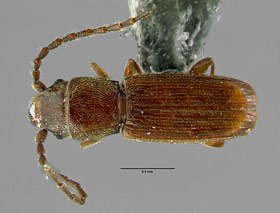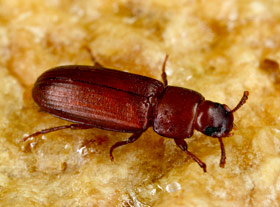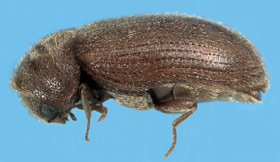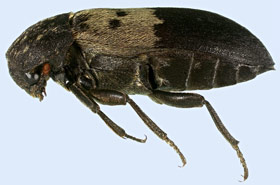Cigarette Beetle, Lasioderma serricorne; Drugstore Beetle, Stegiobium paniceum; Granary Weevil, Sitophilus granarius; Grain Beetle, Oryzaephilus spp.; Flour Beetle, Tribolium spp.

Flat grain beetle. Photo by Gary Alpert, Harvard University, Bugwood.org.
IPM Steps to Reduce Pantry Beetles
1. Sample for Pest
Confirm the presence of these pests.
Where to find it while inspecting: Inspecting for pantry pests should be done in a continual process; look for both evidence of infestations and the conditions that contribute to infestation. With flashlight, tweezers, small bags or jars for collection, and a notepad, look through storage areas, specifically for dry goods such as grains, pasta and flour, spices, nuts and dried fruit for evidence of insects, their eggs and larvae. Due to their small size, you will need to inspect carefully. Look around small and large appliances, food containers and especially any food that is in an open container. Staff should inspect any incoming food for pests. Signs of pantry beetle activity: larva trails in dust or flour dust, strong odors (lemon-rind odor), “shot” holes in packaging from emerging beetles, caste skins from larva. Look in: packaging (stitched seams, folds), between boxes and bags, areas with inactivity such as corners, look on shelving, floors and floor/ceiling and floor/wall junctures. Inspect sticky traps for activity.
2. Proper ID

Red flour beetle. Photo by Peggy Greb, USDA Agricultural Research Service, Bugwood.org.
Before you act, determine what insects are invading your pantry and food storage areas.
Size and Particulars:
3. Learn the Pest Biology
Knowing the life cycle and habitat needs helps you fight these pests.
Life Cycle: Drugstore beetle: larval stage 4–5 months, adult 13–85 days; cigarette beetle: larval stage 1.5–2.5 mo, adult 7–30 days; granary weevil: larval stage 19–34 days, adult 100–182 days; (red) flour beetle: larval stage 12–15 days, adult 6–18 months.
Preferred Food Sources: Drugstore and cigarette beetles are considered “external” feeders (do not bore into grains, beans, etc.). They prefer cereals, spices, seeds, flour and pasta, raisins. Red flour beetle is a scavenger and prefers flour, cereals, grain meals. Granary Weevil is an “internal” feeder and will bore into whole grains such as corn, wheat, rice and into pasta.
Preferred Habitat: Dried foods and their packaging.
4. Determine Threshold

Drugstore beetle. Photo by Natasha Wright, Florida Department of Agriculture and Consumer Services, Bugwood.org.
What are the thresholds for pantry beetles?
Threshold: A general threshold may be 1–10 as the time for a thorough inspection to find the source and is based on monitoring at least twice a month. More then 10 will require a full removal, sanitation and inspection to locate the source and remove it from the building.
5. Choose Tactics
IPM for indoor pests is always a combination of exclusion and sanitation: Try to keep them out. Don’t provide water, food and shelter if they enter your building.
Best Management Practices: The number one way to reduce pantry pests is paired exclusion and sanitation. Inspect any incoming food for pests. Block infestations by keeping all foods in clean, airtight containers. Reduce or use no cardboard or paper packaging, and keep shelf space clean and free of any food debris.
Treatment Methods: Remove any infested products and do a full inspection and cleaning. Sticky traps and pheromone traps may be used to monitor and reduce pests and must be checked daily until infestation is eliminated. Vacuuming is highly useful. Extreme temperatures can kill these insects but not remove them.
6. Evaluate

Larder beetle. Photo by Natasha Wright, Florida Department of Agriculture and Consumer Services, Bugwood.org.
Was the tactic successful? Record the date pests were first noted, and the tactic you used, and its success. Use one of our RECORD KEEPING tools.
For More Information:
Cornell University Insect Diagnostic Lab: Drugstore and Cigarette Beetles
Cornell University Insect Diagnostic Lab: Beetles in Flour, Grains, and Other Stored Foods
Remember:
When a pesticide application is necessary, all necessary and required precautions are taken to minimize risk to people and the environment and to minimize risk of pesticide resistance or pest resurgence. Pesticide use in your school may be prohibited or regulated by local policies or state and federal regulations. Risk reduction methods can include, but are not limited to, spot-treatment, the use of gel or paste bait formulations placed in inaccessible locations, injection into a crack or crevice, and other methods that reduce potential exposure.